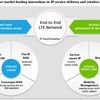By Mae Kowalke
In the U.S., it is no secret that there is a substantial customer as well political interest in seeing that under-served areas have access to state-of-the art communications networks. In fact, it can be argued that the data needs of such critical parts of the economy as agriculture and oil and gas exploration are as intense if not more so than those of industries in densely populated areas. Plus, the desires and expectations of families in the areas are no less important than they are to families in other areas of the country.
What all of this translates into is that while fiber optics and WiFi have allowed most Americans broadband access vast parts of the U.S. have remained under-served for broadband. All of that is changing. As the major wired carriers continue to fiber their franchise areas and the national wireless carriers rush to deploy 4G LTE networks, WiFi hotspots, femtocells, etc. Alcatel-Lucent has been leveraging the capabilities of its lightRadio™ portfolio of solutions to help mobile operators who serve less populous areas provide high-seed services to their customers at price points and performance capabilities that enable customers to enjoy the advantages of next generation devices and all the Internet has to offer in terms of content and applications. And, it allows the operators to do so at competitive prices and at a profit.
“While many of these operators are hardly household names among consumers, don’t let that fool you – these carriers are squarely focused on the needs of their consumers, and are committed to providing them with the benefits (and speeds) that today’s 4G networks have to offer,” noted Sandy Motley, VP of Wireless Accounts at Alcatel-Lucent, on a blog from the recent Rural Cellular Association (RCA) Show in Orlando.
Competitive carriers face several unique challenges, different from national carriers: intense competition, wireless spectrum constraints and limited access to the newest devices consumers crave. That doesn’t stop them from continuing to innovate, though. “While this list of challenges might be daunting to some, competitive carriers are a hearty lot – they see opportunities where others see roadblocks – they have a fiercely loyal customer base and they truly value innovation, in every sense of the word,” Motley said.
This trend toward broadband access being a key to success of local mobile operators via 4G LTE was highlighted by regional wireless service providers Sprocket Wireless and Fuego Wireless.
Like other regional carriers customer demand and competition has pushed them to innovate to survive. This includes not just introducing new technology, but also new business models and new ways of collaborating with other carriers.
Sprocket Wireless and Alcatel-Lucent teamed up to develop fast broadband services for business and consumer customers in Eastern and Southeastern Oklahoma. The 4G LTE network they developed expanded mobile broadband access and availability of services like video calling throughout the region. “By working with Alcatel-Lucent to deploy a 4G LTE network in our service area in rural Oklahoma, we are able to meet the fast-growing demand for mobile broadband services,” explained V David Mill, President of Sprocket Wireless, stated in a recent press release announcing 4G LTE service from his company. He continued that, “These services will help to increase the efficiency of businesses in the region, and support a range of consumer services that have never been seen before in these areas.”
In New Mexico and Texas, Fuego Wireless (a Peñasco Valley Telecommunications brand) has been busy—in collaboration with Alcatel-Lucent—rolling out 4G LTE services to people in the region who have never had access to high-speed internet access before. This region encompasses expansive and diverse terrain, metro areas like Santa Fe and Las Cruces, and rural agricultural communities. They like to highlight that the deployment of 4G LTE brings services to consumers and businesses that have been a communications backwater because of inhospitable terrain and the high-cost of serving the sparse and widely dispersed population.
“Our residents often wait years for the best technology to finally arrive,” said Glenn Lovelace, Chief Executive Officer of PVT, stated in the announcement of Fuego’s rollout of 4G LTE. “Now we are on the leading edge, enabling the most advanced and fastest communications technology available anywhere. Working hand-in-hand with Alcatel-Lucent, PVT will deliver 4G LTE under our new brand Fuego Wireless, so that our customers in New Mexico and Texas can benefit from the same high speeds and quality services that customers enjoy in the largest cities in the world.”
It is interesting to not in both cases the emphasis each company has placed on how important 4G LTE access is to businesses in their respective regions. Fuego pointed out that, “For instance, 4G LTE is able to provide real-time video monitoring of remote locations which can be of great benefit to many industries operating in remote locations, such as the many oil and gas and agriculture companies across New Mexico.”
In both instances, ALU provided complete end-to-end 4G LTE solutions, using LTE base stations and its IP-based Evolved Packet Core, as well as project management, installation, integrations and maintenance services.
At the end of the day, as Motley emphasized, now is the time for competitive carriers to leverage 4G LTE to provide profitable services to customers that can meet most if not all of their broadband needs.










